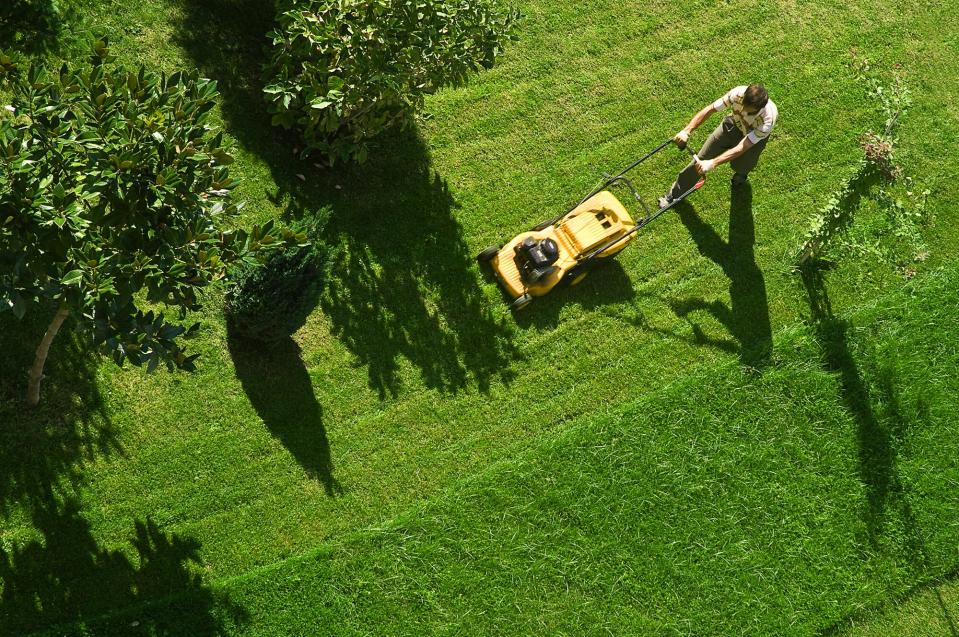Lawn Mowing Tips That Will Make Your Yard the Envy of the Block
TABLE OF CONTENTS
On This Page
Lawn Mowing Frequency
When to Mow Your Lawn
Mower Height
Alternate Mowing Direction
Grass Clippings
Service Mower
When it comes to staying on top of mowing your lawn, it may feel like the grass is greener on the other side—literally. If you have neighbors who seem to have perfected the art of lawn maintenance, it's easy to compare plots. But achieving an equally gorgeous turf is easy—as long as you follow a few lawn mowing tips and best practices every time you give your grass a trim.
Related: The Best Front Lawn Landscape Ideas That Will Boost Your Home's Curb Appeal
How Often to Mow Your Lawn
The general rule of thumb is to cut your grass about once per week, but the correct mowing frequency can vary based on the season and the type of grass you have. "Mow as often as needed to ensure you're not cutting off more than a third of the grass blades at a time," says Ryan Eilermann, senior director of marketing at Spectracide Lawn & Garden. "For many lawns, that's weekly, but some lawns might need mowing more or less frequently. To make sure you are not over-cutting, set a schedule that's easy to follow."

delihayat / Getty Images
When to Mow Your Lawn
While it may be tempting to wait to mow your lawn until later in the day, this can cause unwanted stress on you and your turf. Instead, aim to mow your lawn during the middle of the morning. "Mid-morning is typically best, ensuring the grass has dried from any morning dew or moisture," says Joe Raboine, director of residential hardscapes at Belgard. "It also helps you avoid the heat that sets in later in the day."
Set Your Mower to the Correct Height
Not only will keeping your grass at the right height help it look good, it will also keep weeds at bay. "Mowing the lawn too short can expose soil, increasing the potential for a weed to germinate and outcompete lawn grass," Eilermann says. Wait until your grass is at least 3 inches or taller to mow it, and ensure your mower is set to the right height before going over your grass. "The highest setting is usually best for most lawns, especially when the grass is at the optimal length," Raboine says. "But for the first and last mow of the season, set the mower at a 2.5-inch setting."
Alternate Your Mowing Direction
Changing the direction of your mowing pattern results in aesthetically pleasing lines that run across your landscape. This practice is also good for the health of your turf because it reduces the risk of soil compaction.
"In the professional market, we use the clock as our guide when determining our patterns," says Shawn Kister, associate vice president of horticultural operations at Longwood Gardens. "For example, one time I may mow the lawn starting at the 12:00 position and mow towards 6:00, while alternating back and forth. The next time I mow, I may start at the 3:00 position and mow towards the 9:00 position."
In addition to alternating directions, you should also consider the dimensions of your yard when choosing a mowing path. "If you have a longer yard, cutting vertically is the best option," says Raboine. "Wider lawns benefit from horizontal cuts."
What to Do With Grass Clippings
You can use grass clippings in a variety of ways. "You can leave clippings on your lawn, as they act as a form of fertilizer," says Raboine. If you go this route, be sure to spread the clippings out rather than leaving them in large clumps. Alternatively, thicker clumps of grass can be composted. "You also can use dry clippings as mulch for garden beds, since they are rich with nutrients," says Raboine. No matter how you use your clippings, any clumps with weeds or chemical repellents should be bagged and disposed of.
Service Your Mower Regularly
Ensuring your mower is in tip-top shape will also benefit your grass in the long run. One way to do this is by sharpening your blades regularly, as dull blades result in a torn edge rather than a clean cut. "A general rule of thumb is to sharpen your blades twice per season, or after 25 total hours of use," says Raboine. "You can sharpen blades yourself or take them to a professional."
Additionally, you should have your mower serviced about once a year, barring any issues that may require more frequent maintenance. "The owner's manual from the manufacturer will list when specific maintenance items need to be completed," says Kister. "Typically, the oil change for a homeowner who uses a 21-inch push type rotary mower can be completed one time per year."

